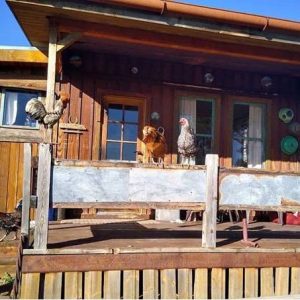On this 50th anniversary of Earth Day, I think about my sister’s prescient and intentional decision to live a life that is marginally dependent on global systems, as locally sourced as possible, and with as light a carbon footprint as she can muster. 
My sister lives on a high mesa in Utah. Her home sits 16 miles up Sand Flats Road, just outside of Moab. She has no power, no water, no cable or WiFi, or connections to the normal things that link most of the rest of us to greater dependence on global systems.
She built the house herself. Since she had no power and everything had to be sawed by hand, she designed the house using standard-sized lumber which required minimal sawing.
She carts water in large containers up from Moab. She wastes none of it, intimately aware of the physical cost of each drop. Two solar panels supply light and power to recharge her cell phone. And all her possessions — her clothes, furniture, kitchen containers, plates and utensils — are from thrift stores or are found objects.
She has always said that she “is just living the life the rest of us are going to have to get used to.” For her, there was no painful transition to the COVID-19 shutdown,other than spending as little money as possible, since much of her income is derived from people coming in from outside the area.
While we can’t and shouldn’t all live like my sister, we can all take a hard look at the decisions we make, and how those of us engaged in economic development turn our minds and resources towards intentional recalibration — in federal and state policy and in on-the-ground investment.
We are all experiencing the economy unraveling. But it turned out to have been a very fragile economy based on ever-growing consumption and a zero-sum approach, where a few at the top gain at the expense of so many. The fissures in the global economic system have cracked wide open, revealing two deep flaws — inequity and ecological havoc.
Heart-breaking data and stories are emerging about the toll of the virus as it exposes structural inequalities. People who actually make the economy run — the drivers, the grocery store and food supply workers, low-paid health care workers, people it turns out EVERYONE else depends on — who were already in deeply precarious positions, are now being displaced in droves.
While the virus infects people regardless of wealth, the poor and people of color have been disproportionately impacted. According to Nicky Hylton-Patterson, Director of the Adirondack Diversity Initiative, Coronavirus is exposing the toll that systemic racism and oppression has had on our nation. In her upcoming blog “The Color of Climate Change: Coronavirus & the vulnerable among us,” she argues that “systemic inequities have left track marks on the bodies and lives of communities of color, the poor, differently abled, and those whose identities have positioned them for marginalization. These track marks of inequity exposed by Coronavirus, are symptoms of the historic segregation of the racial, ethnic and low-income or poor Other. The outcome: People of color and low income communities have been forced to reckon with chronic illnesses such as diabetes, heart disease and asthma, exacerbated by the cycle of decreasing air quality and limited access to comprehensive healthcare, making them exponentially more vulnerable to COVID-19.”
Additionally, rural communities — those that ANCA directly serves — are at risk. Rural economies were the hardest hit by the 2008 recession and the slowest to recover. Businesses were hit especially hard — in the first four years of the recovery, counties with a population less than 100,000 lost 17,500 businesses, compared to economies in counties over one million people which added 99,000. COVID-19 will only exacerbate these pressures; the shutdown of commerce has already put small businesses, key drivers of rural economies, into a tailspin.
At the same time, a nearly shuttered economy has dramatically reduced carbon emissions and air pollution, showing us what a world could look like when giant steps to reduce dependence on fossil fuels have happened. The skies above Los Angeles are clear. The air pollution in major global cities is much lower.
This is a time to reconsider what is important to us. Equity and ecology need to be front and center in every decision we make: how we vote, where we invest whatever resources we have, the policies that we call on our elected representatives to implement, the programs that need to be in place to prevent a crisis like this from happening again. All of these are critically important decisions.
Equity and ecology. Those are front and center as ANCA maps our five-year plan.
We strive to grow a New Economy that is inclusive, just and resilient — an economy that is bolstered by these ideals:
Local Ownership. Our short-term efforts are focused on helping local businesses survive. Longer term, the high multiplier benefits of local businesses buying from one another strengthen local economies.
Local Investment. Short-term efforts focus on people changing default habits that support global giants like Amazon to supporting local businesses like local farms and Main Street businesses. Longer term, it means that people, the government, finance institutions, philanthropists, and nonprofits are all working to invest locally.
Economic Diversity. How self-reliant is our economy? The more self-reliant we are — on local food, energy, water and finance — the less global disruptions will impact us.
Social Equity. Is our local economy leaving anyone behind? Does our community ensure that all its members across race, class, gender, sexual orientation, ethnicity, national origin, age and ability are able to fully participate in the local economy? ANCA’s programs strive for inclusivity and embrace social innovations like cooperative ownership.
Regeneration. Is our economy living within its natural means? For goods like food, water, wood, and paper, we will need to bring inputs of our diverse economies in line with what our local ecosystems can provide in renewable ways.
There will be huge pressure on us all to return to “normal” as quickly as possible. But from a moral perspective, we should not return to normal. And from a survival perspective, we cannot return to normal. What comes out of this crisis needs to be different — and better.
Stay tuned for the next What’s Up North blog by Nicky Hylton-Patterson: “The Color of Climate Change: Coronavirus & the vulnerable among us.”
